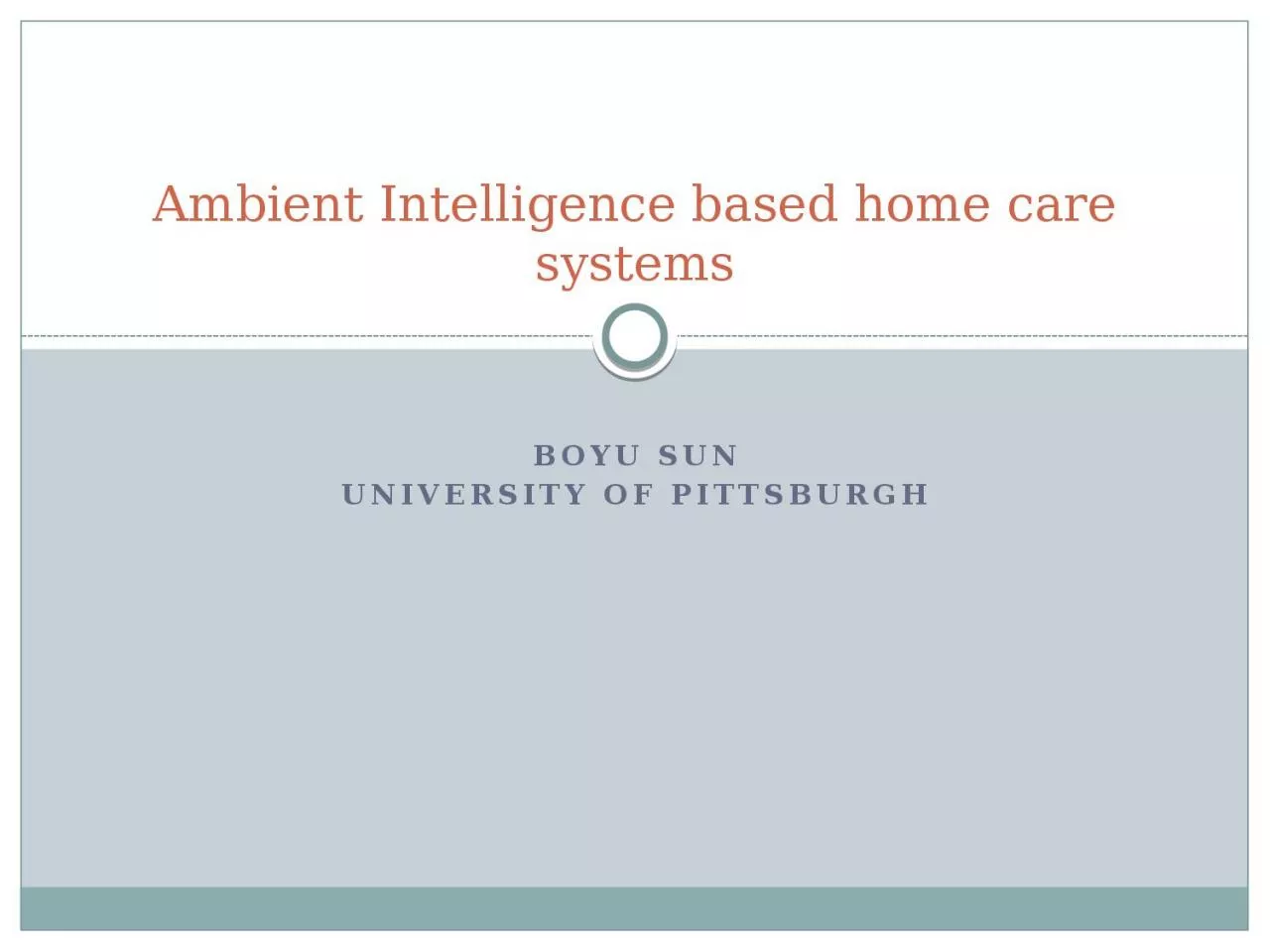

Ambient Intelligence based home care systems P rologue The most profound technologies are those that disappear They weave themselves into the fabric of everyday life until they are ID: 1034582
Download Presentation The PPT/PDF document "Boyu Sun University of pittsburgh" is the property of its rightful owner. Permission is granted to download and print the materials on this web site for personal, non-commercial use only, and to display it on your personal computer provided you do not modify the materials and that you retain all copyright notices contained in the materials. By downloading content from our website, you accept the terms of this agreement.
1. Boyu SunUniversity of pittsburghAmbient Intelligence based home care systems
2. Prologue“The most profound technologies are those that disappear. They weave themselves into the fabric of everyday life until they are indistinguishable from it” --Mark Weiser
3. A quick look at ambient intelligenceambient intelligence (AmI) refers to electronic environments that are sensitive and responsive to the presence of people, which is built upon:Ubiquitous computingProfiling practicesContext awarenesshuman-centric computer interaction design
4. Typical ContextHome environmentStable communication infrastructureWell defined types of context informationReliable quality and reachability of services
5. Classification of the Home Care System(HCS) Domain
6. Problem with current HCSLow acceptance of health assistance solutions Technology focus – ignore usability issuesLow assistance and qualityRely on single modality for sensing having great limitationNot aware of contextDifference between a person just climbed stairs and sitting in a chair for a long time Static, unnatural interfacerequires some learning and results in a higher probability of misoperation with growing age
7. Characteristics of AmI systemAmI is characterized by systems and technologies that are:embedded: many networked devices are integrated into the environmentcontext aware: these devices can recognize you and your situational contextpersonalized: they can be tailored to your needsadaptive: they can change in response to youanticipatory: they can anticipate your desires without conscious mediations
8. How could AmI helpAmI has huge potential in the area of living assistance for handicapped and elderly people suffering from all kinds of disabilities, detecting:Gait changesNeurological alternationsVisual acuity changesSpontaneous fractures and fallsSudden changes in blood pressure
9. GoalThe ultimate goal of any emergency treatment system must be: high recall: detecting every real emergency immediately, and high precision to prevent invalid emergency detections and alerts as a consequence of misinterpretations. High recall is mandatory to provide a trustworthy service quality to the assisted persons in case of emergency situations. High precision is essential for economical reasons, since invalid emergency alerts may decrease trustworthiness unacceptably and increases care costs.
10. Human Capability Model (HCM)provide a precise notion for critical situations and emergency casesmust allow personalizing the servicetaking the existing disabilities of a person into account
11. Trace and situationsTrace: An approximation of this(HCS) model which is achieved by continuously acquiring data about a persons' vital functions such as temperature, blood pressure, and pulse together with data on his short-term, medium-term, and long-term behavior.Situations: The current situation of an entity can be characterized by means of logical predicates denoted as situations
12. ExampleSimple situations examples:Person X has a blood pressure of 178 Person X is sleeping Person X has not taken medicine M for 2 days Complex ones(Person X has fallen down) AND (Person X has not responded to call for 30 seconds)Use inference rules for action suggestion(Person X has fallen down) → (Call Person X) (Person X has fallen down) AND (Person X has not responded to call for S seconds) → (Issue emergency call)
13. Architecture considerationOn the highest level of abstraction, an AHCS appears as some kind of closed loop controller that senses its environment and especially the persons living therein and influences the environment with its actuatorsOn a detailed level, core functionality can be decomposed into six functional units as:SensingPerceptionIdentificationAssistingControllingActing
14. Functional Blocks of AHCS
15. Real life application -- AMICADesigned at the Fraunhofer Institute for Experimental Software Engineering (IESE) in Kaiserslautern, GermanyFollows the AHCS vision, Iteratively developedShall be evolved into a full-fledged AHCS prototype within the next two to three years.
16. Current featuresMonitored Drinking: computerized cup (iCup) the amount of fluids consumed by the person handling the cup is measured potential thus dehydration can be detected and signaled to the care giversMonitoring Food Quality: An RFID-based system built into a refrigeratorLocation Tracking: By means of RFID labels embedded in the carpet, and mounted to the ceilingFall detection: Gyro sensors built into wrist badges, walking aids, or other body mounted devices
17. Thank you
18. ReferenceBecker, Martin; Werkman, Ewoud; Anastasopoulos, Michalis; Kleinberger, Thomas; , "Approaching Ambient Intelligent Home Care Systems,"Pervasive Health Conference and Workshops, 2006 , vol., no., pp.1-10, Nov. 29 2006-Dec. 1 2006Jurgen Nehmer, Martin Becker, Arthur Karshmer, and Rosemarie Lamm. 2006. Living assistance systems: an ambient intelligence approach. In Proceedings of the 28th international conference on Software engineering (ICSE '06). ACM, New York, NY, USAAarts, E.; , "Ambient intelligence: a multimedia perspective," Multimedia, IEEE , vol.11, no.1, pp. 12- 19, Jan.-March 2004